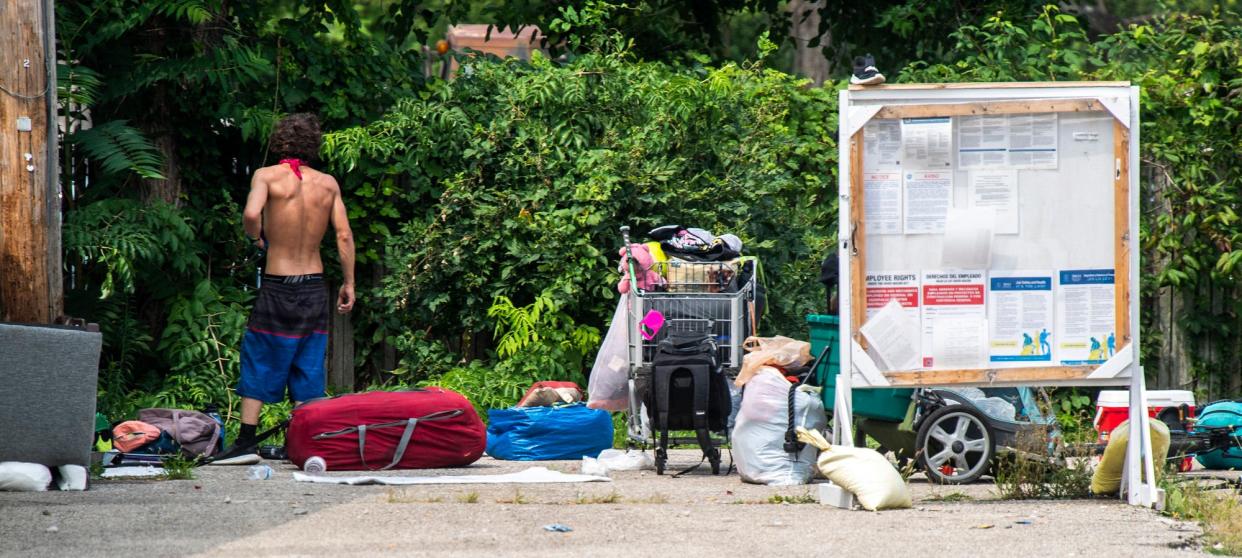How could Bloomington approach solutions to homelessness?

Homelessness has presented some of the most intractable challenges for the Bloomington area. The city and county have spent hundreds of thousands of dollars to clear encampments as high housing costs and low wages are pushing more people into homelessness or to the brink, and a lack of addiction and mental health services keep many people trapped in a cycle between living in shelters and on the streets.
The path to homelessness: How one Bloomington veteran ended up sleeping in his truck
As Mayor-elect Kerry Thomson, who has a background in affordable housing, takes office in about a month, advocates for homeless people, city officials and academics recently offered some possible solutions to making homelessness rare, brief and non-repeating.
Solving homelessness with an emergency management approach
David Henry, an adjunct instructor at Indiana University’s Paul H. O’Neill School of Public and Environmental Affairs, said rather than clearing camps of homeless people, communities could foster collaboration among government agencies and community organizations to help people long-term.
Henry, chair of the local Democratic Party, has lectured on, among other things, homeland security and emergency management policy.
Some communities, including Spokane, Washington, and Minneapolis, have successfully taken an emergency management approach to homeless camps, he said. In Spokane, the city triaged the encampments much as it would have responded to a tornado or flood, by building emergency shelters and connecting people with local resources to address the underlying issues that kept people unhoused.
According to the Washington State Department of Commerce, Camp Hope, in Spokane, provided shelter for more than 600 people in summer 2022. The state closed the camp in June after moving the last individual from that camp into housing. The work involved three state agencies and community partners.
“This work requires collaboration with local governments and community partners,” Gov. Jay Inslee said in a news release. “Legislators this session approved new policies and historic funding to help communities build more affordable housing and expand access to substance use treatment, behavioral health and other services.”
Henry said the governments of the city of Bloomington and Monroe County could adopt a similar model to collaborate on a solution rather than having local decision makers attack the problem in a piecemeal fashion.
Solving homelessness by providing housing first
The Rev. Forrest Gilmore, executive director of Beacon, a Bloomington-based nonprofit that operates the Shalom Center day shelter, said the community must focus first on providing housing to people who want it.
“We need to address the core issue,” he said.
Shalom's new location: Bloomington homeless shelter to be moved, get 20 apartments. Find out where.
Providing people temporary shelter — but failing to offer permanent housing — works for some people, but also threatens to create a permanent underclass of people who are trapped between temporary shelters and homelessness, he said.
“Until we really solve that problem, we’re going to have a significant homeless problem in our community,” Gilmore said.
Providing permanent housing first, he said, will allow government organizations and nonprofit agencies to help people deal with underlying problems much better than when they’re bouncing back and forth between temporary shelters and homelessness.
Micro communities as an interim solution to homelessness

Bloomington City Council member Isabel Piedmont-Smith said she agrees that housing must come first — or least right after the city decriminalizes homelessness.
Piedmont-Smith said she and some of her colleagues tried to do just that in 2021, in a now infamous nine-hour city council meeting that ended with eight members being deadlocked.
Providing housing is critical to being able to address the underlying issues that contribute to people being unhoused, she said.
A person can't be expected to address their mental health or addiction problems if they have no place to lay their head at night, Piedmont-Smith said. How can someone stay on medication if they don’t know what time it is or if they have no way to get to a doctor?
That means the housing the community has to provide cannot be just four walls and a roof, but must also include support services, she said.
Piedmont-Smith this year traveled with two council colleagues — Kate Rosenbarger and Matt Flaherty — to a conference in St. Louis where elected officials discussed housing and listened to presentations by government officials from Sacramento, California; Oklahoma City; and Denver.
In Colorado, government officials in July opened the Denver Emergency Operations Center where more than 50 city employees are working to bring 1,000 homeless people indoors by the end of the year, in part by buying hotels and building micro communities that include tents and tiny homes, shared kitchens and bathroom facilities along with around-the-clock staffing.
According to Axios, the plan to house 1,000 homeless people will cost nearly $50 million.
Piedmont-Smith said Denver officials used some marijuana tax and COVID-19 relief dollars and proclaimed a housing state of emergency to make available other state and federal dollars.
In Bloomington, the city, too, could try to find a property for a safe micro community, preferably close to needed services, she said. Those communities would serve as interim solutions, not permanent housing, but they would be a way to get people out of encampments.
“I don’t think encampments are safe for anybody right now, but people need a place to go,” Piedmont-Smith said.
Severity, complexity, underlying issues

Eric Spoonmore, president and CEO of the Greater Bloomington Chamber of Commerce, said homelessness has many causes, including extreme poverty, substance use disorders and mental health challenges.
“If we can’t meaningfully address those underlying root causes, I don’t know how we’re going to make any significant impact on getting more people housed,” he said.
The community cannot arrest its way out of the problem, but has to figure out how to provide treatment and counseling, he said.
Spoonmore, a former county councilman, also said Monroe County cannot address the underlying issues alone and the problem requires “massive” resources and state and federal interventions.
“This is the grand challenge of our decade,” Spoonmore said.
If the community cannot find a way to foster more construction of homes, he said, an increasing number of employers are going to set up shop in Ellettsville, where community leaders appear to have a clear vision for what they want. Spoonmore said the tight housing market in Bloomington and Monroe County is likely to produce more construction in the corridor between Ellettsville and Bloomington — with voluntary annexations around Ellettsville.
The homelessness problem’s complexity is perhaps exemplified by the number of cities who appear unable to solve it. Denver officials, for example, are running into some problems with their preferred solution: Mayor Mike Johnston recently withdrew one neighborhood targeted for a micro community after pushback from residents.
Russ Skiba, professor emeritus in the School of Education at Indiana University, said the problem’s complexity requires a thoughtful response. Skiba suggested putting together a task force that includes researchers from IU to find evidence-based solutions and to look at which communities have taken the most effective steps to combat homelessness.
What steps has the city of Bloomington taken to address homelessness?
A spokeswoman for the administration of Mayor John Hamilton said the federal government for decades “has stepped away from this issue, making it fall squarely on local governments.
"Housing should be a right for everyone, and significant national funding would be required to realize that goal," Angela Van Rooy, the city's interim communications director, said via email. "One possibility would be significantly increasing the number and value of housing vouchers through the Bloomington Housing Authority, but the federal funding needed is not available."
Van Rooy also said the city has taken the following steps to address homelessness:
Expanded housing options: The city has committed $2.7 million in direct funding to support Heading Home, which “employs both short- and long-term strategies that City departments coordinate and work on every day.” The city’s Housing and Neighborhood Development Department is allocating $2 million in COVID-19 relief dollars to assist, in the next five years, people who are homeless or at risk of homelessness “through development of rental housing and supportive services case management.”
Met weekly with social service providers to coordinate the funding of shelters.
Advocated for more mental health/addiction services: That includes $1 million in COVID-19 relief dollars for public health programs and ongoing support for the STRIDE Center. “Additionally, our Community and Family Resources Department (CFRD) provides mental health training and aid to staff of local nonprofits, the County, the City, and downtown businesses.”
What steps has Monroe County taken to address homelessness?
Penny Githens, president of the Monroe County commissioners, too, said the situation has gotten worse in part because state and federal governments have reduced their help.

“Several years ago the State of Indiana closed down most of its mental health hospitals without providing an adequate safety net for former patients. In a nutshell, the State of Indiana failed to develop a fully-funded mechanism for providing care and housing for these individuals,” Githens said.
Part of the problem locally, she said, is that wages are too low to allow many people to afford homes in the area.
GIthens said the county has taken steps to help address the challenges, including:
Providing COVID-19 relief dollars to Heading Home, which has helped coordinate housing for 16 unhoused veterans this year.
Maintaining housing density: Commissioners this summer declined to decrease the density proposed for the Fieldstone subdivision.
Githens said two factors out of the commissioners’ hands contribute to making housing more expensive in Monroe County: The cost of land and the City of Bloomington Utilities refusing to provide sewer hookups outside of the city until annexation, now pending in court, has been resolved.
Boris Ladwig can be reached at bladwig@heraldt.com.
This article originally appeared on The Herald-Times: What Bloomington could do to make homelessness brief rare nonrepeating

